| Author |
Message |
J.D. Crawford

|
 Posted: Sat 26 Jan, 2019 7:06 am Post subject: Posted: Sat 26 Jan, 2019 7:06 am Post subject: |
 |
|
| Craig Peters wrote: | | J.D. Crawford wrote: | | The 'Korsoygaden' Sword [SIC] is one of my favorites. It has an asymmetic guard. But when I had it replicated, I asked for a symmetric version to meet modern our sensibilties:http://myArmoury.com/review_helmes_korsoygaden.html |
Looks like the lower terminal of the cross (in the photo) is noticeably thicker, and the "clubbed" end more pronounced. Is there anything else I missed? |
Vkverir has excellent detail shots on this and a lot of other scandanavian swords: http://www.vikverir.no/ressurser/hist_mus_osl...amp;page=2
Another thing off is that the 'ecusson' does not align with the fuller.
|
|
   |
 |
Craig Peters

|
 Posted: Sat 26 Jan, 2019 6:03 pm Post subject: Posted: Sat 26 Jan, 2019 6:03 pm Post subject: |
 |
|
For the sake of convenience, I have attached a photo to illustrate this detail:

|
|
  |
 |
Craig Peters

|
 Posted: Sat 26 Jan, 2019 6:24 pm Post subject: Posted: Sat 26 Jan, 2019 6:24 pm Post subject: |
 |
|
The Vikverir website photos from the Museum of Cultural History in Oslo have an excellent example of a sword whose appearance is eccentric. Not only are the hilt furnishings "aesthetically odd" to many modern people, but they're also far from symmetrical. Regarding the former, the pommel of this sword is unusual although there are other swords with pommels like it. The cross guard, however, looks more along the lines of something you might have seen on a 1990's fantasy-style sword. Paired together, the pommel and cross make for highly unusual hilt furnishings that certainly would not be to everyone's taste. Regarding the latter, the symmetricality, the "trough" between the two undulations on either side of the cross is noticeably different. Even the length of the two arms of the cross does not seem to be the same; notice the apparent width of the gap between the inner undulation and the blade itself. As on many swords, there is a significant gap between the cross guard and the tang.
All in all, a great example of a sword that does not fit many modern people's aesthetics.



|
|
  |
 |
Craig Peters

|
 Posted: Sun 27 Jan, 2019 9:43 pm Post subject: Posted: Sun 27 Jan, 2019 9:43 pm Post subject: |
 |
|
Here's an image from Peter Johnsson's and Eric McHugh's trip to Husbyborg in 2003. As far as I can tell from this image, the fuller is not perfectly centered along the tang; it looks like it's biased to one side. Of course, one might argue that a "flaw" of this nature is inconsequential; after all, when the sword was in use, the tang would have been covered with wood and some sort of grip. Yet, seeing this detail is still of relevance, as it gives a good indication of the kind of eccentricities and irregularities that were perfectly acceptable to a medieval blade smith. Notice, also, that the fuller drifts slightly as it proceeds further down the blade.
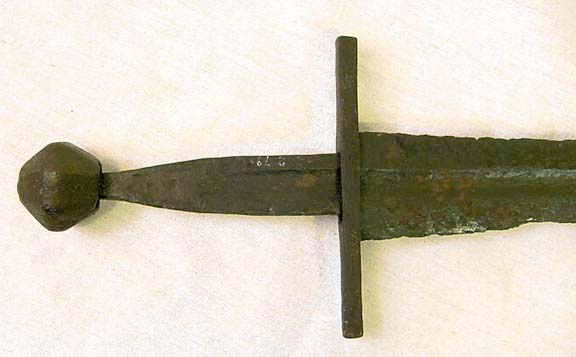
|
|
  |
 |
Michael P. Smith

|
 Posted: Mon 28 Jan, 2019 6:13 am Post subject: Posted: Mon 28 Jan, 2019 6:13 am Post subject: |
 |
|
| Craig Peters wrote: | | Victor R. wrote: |
I might elongate the cross a little, but I'd love to see that pommel on a sword I own. |
The question is: can you resist the temptation to "fix" this sword? ;-) |
HAHA.... NO! I know some (quite a few) historical examples have short guards. But they still look wrong to my eyes. It's like a 80's Volvo... There is no doubt it was a good car (and undeniably "authetnic," but I still think it's ugly.
But I kid a bit. I actually wouldn't mind having such an example in my collection, but not sure I'd pay top dollar for one. Del Tin makes the DT5149, which is the only production sword I am aware of that replicates this aesthetic.

|
|
  |
 |
J.D. Crawford

|
 Posted: Mon 28 Jan, 2019 8:45 am Post subject: Posted: Mon 28 Jan, 2019 8:45 am Post subject: |
 |
|
It's interesting that antique collectors appreciate such imperfections; they add value because they distinguish hand-made products from the sterile factory-made items we get today. And yet one does get sucked into 'perfect' swords. When I first started collecting reproduction swords I still had that antique-collector mindset and did not like Albions because they looked 'too perfect', but now, after years of collecting, imperfections bug me unless they are intentional.
Perhaps one factor behind this current obsession is that in modern products, visible imperfections often correlate with functional imperfections, whereas in traditionally hand made items that is not necessarily so. If you watch 'forged in fire', you'll see that sometimes the ugly blade ends up winning because the beautiful one breaks in half during testing. Viking sagas often mentioned 'proven weapons'. This had to be a huge concern, more than appearance, when your life was on the line.
|
|
   |
 |
Craig Peters

|
 Posted: Mon 28 Jan, 2019 10:11 pm Post subject: Posted: Mon 28 Jan, 2019 10:11 pm Post subject: |
 |
|
|
Yes, I'm sure a lot of people's concerns stem from the relationship between visual defects and handling defects. Nevertheless, anything that can help to shift our perceptions to a more authentic "medieval" way of perceiving swords will help the sword industry better create replicas that reflect real swords.
|
|
  |
 |
Craig Peters

|
 Posted: Mon 28 Jan, 2019 10:20 pm Post subject: Posted: Mon 28 Jan, 2019 10:20 pm Post subject: |
 |
|
This sword is well-known to many sword enthusiasts thanks to Ewart Oakeshott, Royal Armouries IX.5614. What I wanted to draw attention to was just how dramatic the swelling at the ends of the cross is. Usually, modern makers will "tone-down" this swelling to make it more proportional to the sword as a whole, but that isn't part of the medieval aesthetic of this sword. Now, one might argue that this swelling is only to accommodate the presence of the babewyns and that the cross would have hardly been this size otherwise. However, it would certainly be possible for the artisan to have created a smaller rendering of these groteques had they wanted to. Perhaps more relevant, we have examples of other swords, like the XVI.a posted as sword fifteen, above, that show widely flared crosses without such decoration. Therefore, it's a mistake to assume that the swelling on this cross is only due to the artwork.

Last edited by Craig Peters on Tue 29 Jan, 2019 11:50 pm; edited 1 time in total
|
|
  |
 |
Michael P. Smith

|
 Posted: Tue 29 Jan, 2019 6:18 am Post subject: Posted: Tue 29 Jan, 2019 6:18 am Post subject: |
 |
|
|
A guard like that reminds me of the super wide lapels and ties of the 70’s.... a fairly extreme expression of a fashion mode.... not dissimilar to the super long “krakow” pike shoes of the late 14th-15th century. Or modern “couture” clothing. After all, fashion of the very wealthy is often about being noticed before actual aesthetic appeal.
|
|
  |
 |
Craig Peters

|
 Posted: Tue 29 Jan, 2019 9:03 pm Post subject: Posted: Tue 29 Jan, 2019 9:03 pm Post subject: |
 |
|
Another from the Royal Armouries, IX.1107 and again a well-known sword thanks to Oakeshott. Notice the "ecusson" is noticeably off-center to the fuller, perhaps a product of the blade and hilt being made separately, with the latter not being customized to fit the former. The fuller starts out fairly clean and sharp, but notice that as reaches approximately 2/3rds of its length it becomes much less clean with irregularly shaped edges. The cross is fairly symmetrical, although I think there is a difference in the angle of the sloping terminals, with the right side appearing to be a somewhat flatter angle than the left.

|
|
  |
 |
|
Adam Bodorics
Industry Professional
|
 Posted: Wed 30 Jan, 2019 11:34 pm Post subject: Posted: Wed 30 Jan, 2019 11:34 pm Post subject: |
 |
|
Stumbled across this photo. The waver of the edge could be the result of continuous resharpening, but the medial ridge is also all over the place. Also the tip is very off-line.
Edit: I added a baselard as well, with quite obvious and deliberate asymmetry. It seems like they made these this way at times, I guess to make them more comfortable to wear. This is also something we (or at least I) don't see reproduced too often, even though it makes sense, is easier to make, is surprisingly comfortable and completely historical.
 Attachment: 30.36 KB Attachment: 30.36 KB
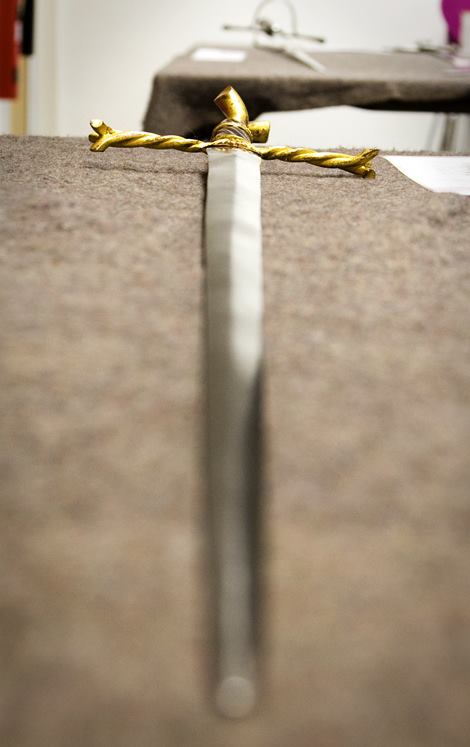
 Attachment: 135.33 KB Attachment: 135.33 KB
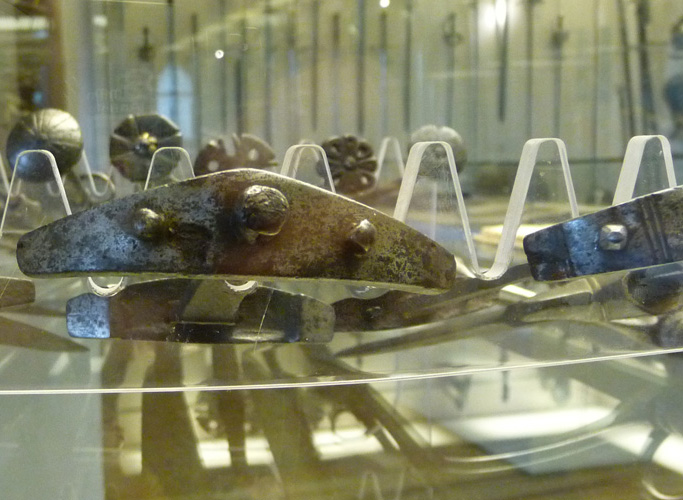
|
|
  |
 |
|
Adam Bodorics
Industry Professional
|
 Posted: Thu 31 Jan, 2019 12:00 am Post subject: Posted: Thu 31 Jan, 2019 12:00 am Post subject: |
 |
|
Also, all the crosses of this type I've seen up close personally (all 3 of them, so it's not that representative  ) turned out to be actually rather crude, even with the decorations. I can't find the specific photo I had in mind originally, it's from the Déri Museum, Debrecen - the welds and rolled elements looked like they were made from putty by someone with not too much patience. Really impressive from a few steps away, and really... organic when looked at from close up. The one I posted looks a cleaner job than those, but it's still much more organic than what we're probably used to. ) turned out to be actually rather crude, even with the decorations. I can't find the specific photo I had in mind originally, it's from the Déri Museum, Debrecen - the welds and rolled elements looked like they were made from putty by someone with not too much patience. Really impressive from a few steps away, and really... organic when looked at from close up. The one I posted looks a cleaner job than those, but it's still much more organic than what we're probably used to.
 Attachment: 236.31 KB Attachment: 236.31 KB
[ Download ]
|
|
  |
 |
Craig Peters

|
 Posted: Thu 31 Jan, 2019 1:25 am Post subject: Posted: Thu 31 Jan, 2019 1:25 am Post subject: |
 |
|
Adam,
Is the first photo of the sword from the Royal Armouries? If so, this angle provides a much clearer perspective to see the idiosyncrasies of the blade.
|
|
  |
 |
Craig Peters

|
 Posted: Thu 31 Jan, 2019 1:40 am Post subject: Posted: Thu 31 Jan, 2019 1:40 am Post subject: |
 |
|
Here's an example of a sword's pommel. Notice the inner "hub" is quite small, and you can see that the cross has been completed fairly hastily and without a great deal of precision. The temptation exists for modern people looking for a reproduction sword to request a smith to "fix" these qualities, by widening the hub, and/or making the cross neater, larger. Yet the authentic medieval aesthetic, at least for this pommel, is small and irregular.
 Attachment: 18.35 KB Attachment: 18.35 KB
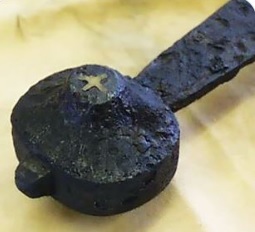
|
|
  |
 |
Craig Peters

|
 Posted: Thu 31 Jan, 2019 11:00 pm Post subject: Posted: Thu 31 Jan, 2019 11:00 pm Post subject: |
 |
|
Another sword from the Royal Armouries, inventory number IX.5427. The sword is identified as a boy's sword, due to its overall length of 62 cm (24.4 inches). On the basis of coins of Edward IV nearby, the sword is dated to circa 1460-1485 AD. The cross on this sword is slightly asymmetrical with the right arm being wider than the left. Notice the flattened spherical pommel is irregularly shaped, no matter what the sword might have looked like when it was in pristine condition.
 Attachment: 20.4 KB Attachment: 20.4 KB
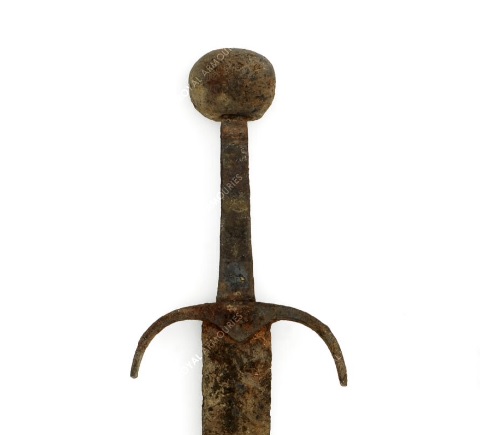
|
|
  |
 |
Craig Peters

|
 Posted: Fri 08 Feb, 2019 10:43 pm Post subject: Posted: Fri 08 Feb, 2019 10:43 pm Post subject: |
 |
|
Here is sword 458 from the Wallace Collection. You can see that the cross guard is not even; the left terminal is shorter than the right, and there is a difference in the shape of the clubbed ends. What is also noteworthy is the extraordinary thinness of the pommel, reminiscent of Sword 11 in my initial post.
The images are from Vikverir.


|
|
  |
 |
Craig Peters

|
 Posted: Fri 08 Feb, 2019 11:05 pm Post subject: Posted: Fri 08 Feb, 2019 11:05 pm Post subject: |
 |
|
|
I have a question. Are some medieval blades thinner in diameter than we tend to see on modern reproductions? I have the impression from some of the antique swords, particularly those with fullers or with earlier style, hewing oriented blades (Type X, Xa, XI, XI.a, XII, XIII.b) that on occasion, the swords have much thinner blades than what we tend to see on modern replicas. Of course, it's hard to be certain from photos how thick the swords are, and obviously, age and degradation will have an impact on the blade thickness. Nevertheless, does anyone else share this impression?
|
|
  |
 |
Nathan Robinson
myArmoury Admin


|
 Posted: Sat 09 Feb, 2019 1:13 am Post subject: Posted: Sat 09 Feb, 2019 1:13 am Post subject: |
 |
|
| Craig Peters wrote: | | I have a question. Are some medieval blades thinner in diameter than we tend to see on modern reproductions? I have the impression from some of the antique swords, particularly those with fullers or with earlier style, hewing oriented blades (Type X, Xa, XI, XI.a, XII, XIII.b) that on occasion, the swords have much thinner blades than what we tend to see on modern replicas. Of course, it's hard to be certain from photos how thick the swords are, and obviously, age and degradation will have an impact on the blade thickness. Nevertheless, does anyone else share this impression? |
There are certainly many antique swords that I've seen in museums that are quite thin, both in blade and in the components of the hilt. I've seen very few modern made swords that replicate this. Frankly, I can't remember off-hand any examples. Things have gotten better in the replica market over the last decade or so. Before that, most swords were by and large overbuilt and oversized by a pretty extreme amount. You still see this, of course, particularly on less expensive options.
.:. Visit my Collection Gallery :: View my Reading List :: View my Wish List :: See Pages I Like :: Find me on Facebook .:.
|
|
    |
 |
Nathan Robinson
myArmoury Admin


|
|
    |
 |
|
Chris Dayton
Location: Austin, TX Joined: 29 Oct 2017
Posts: 66
|
 Posted: Sun 10 Feb, 2019 5:35 am Post subject: Posted: Sun 10 Feb, 2019 5:35 am Post subject: |
 |
|
| Craig Peters wrote: | | I have a question. Are some medieval blades thinner in diameter than we tend to see on modern reproductions? I have the impression from some of the antique swords, particularly those with fullers or with earlier style, hewing oriented blades (Type X, Xa, XI, XI.a, XII, XIII.b) that on occasion, the swords have much thinner blades than what we tend to see on modern replicas. Of course, it's hard to be certain from photos how thick the swords are, and obviously, age and degradation will have an impact on the blade thickness. Nevertheless, does anyone else share this impression? |
Interesting question and I look forward to seeing a range of responses.
This may not be exactly medieval, but I have a mid-1600s Scottish broadsword with what I suspect is an earlier blade with shallow fullers, very hewing-oriented. I've pasted the dimensions below. It is indeed surprisingly thin, such that it droops slightly under its own weight when held horizontally.
Weight/mass: 2 lb 4.2 oz; 1.03 kg
Total length: 43.9”; 111.5 cm
Blade length: 39.0”; 99.1 cm
Basket max length: 4.75”; 12.1 cm
Basket max width: 4.25”; 10.8 cm
Grip length: 3.5”; 8.9 cm
Blade max width at guard: 1.38”; 3.5 cm
Point of balance: 5.75”; 14.6 cm
Distal taper of the blade: 0.24” or 6 mm thick at guard to 0.08” or 2 mm thick 4” or 10 cm from the tip
|
|
  |
 |
|
|
You cannot post new topics in this forum
You cannot reply to topics in this forum
You cannot edit your posts in this forum
You cannot delete your posts in this forum
You cannot vote in polls in this forum
You cannot attach files in this forum
You can download files in this forum
|
All contents © Copyright 2003-2024 myArmoury.com — All rights reserved
Discussion forums powered by phpBB © The phpBB Group
Switch to the Basic Low-bandwidth Version of the forum
|

